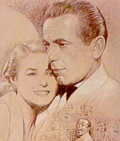|
Study Guide -
The Crucible (1996)
Director : Nicholas Hytner
Stars :
Daniel Day-Lewis .... John Proctor
Winona Ryder .... Abigail Williams
Paul Scofield .... Judge Thomas Danforth
Joan Allen .... Elizabeth Proctor
Bruce Davison .... Reverend Parris
Charlayne Woodard .... Tituba
Preparation :
Read the movie reviews by Roger Ebert, the New York Times and by James Berardinelli. Also read the article on the McCarthy Hearings and "An Account of the Events in Salem."
Historical/Social Significance :
Arthur Miller who wrote the play and the screenplay for this movie said that he wrote the play because he saw that the nation was going through the same things in the 1950's that Salem was going through back in 1692. Miller never claimed that the play was historically accurate, although it roughly corresponds to events in 1692 Puritan Salem where 19 villagers were hung as witches and one died of "pressing". First produced on Broadway on January 22, 1953, it was in response to the panic caused by irrational fear of Communism during the Cold War which resulted in the hearings by the House Committee on Unamerican Activities. Elia Kazan's testimony before it -- which is assumed to have influenced Miller -- was on April 12th, 1952. Miller, later called before the committee was indicted for contempt for refusing answer the committee's questions about communists he had known. Note : The play actually premiered before anti-Communist Senator Joseph McCarthy's actual participation on the HCUA committee started on Feb. 3, 1953.
This movie also shows political and social life in 17th century New England with "...knockout location filming and period detail (coutroom, chapel, and household sets, picture-postcard farms, hand sewn costumes)"1
"The Crucible straddles two different worlds to make them one, but it is not history in the usual sense of the word, but a moral, political and psychological construct that floats on the fluid emotion of both eras. " Arthur Miller (2000)
Synopsis :
The film opens with some Salem village girls attending a secret voodoo ritual in the woods. When the local preacher views the proceedings the girls start blaming some of the villagers as servants of Satan. One of the girls, Abigail, wants to eliminate the wife of the man she loves (John Proctor).
Guided Questions for Viewing :
Assessment questions will be based on the following :
-
Pick one person you would pick to be a hero in this movie. Defend your choice with examples.
-
A teenage girl getting spurned is not part of the original Salem story. Why do you think Arthur Miller included this in his story?
-
The Crucible is about the occurrence in Salem, Massachusetts, in 1692, but it will never adhere to that specific time period, and neither will it only represent the time it was written for. The message that Miller is trying to get across is that we must think about our position in society. We are blind to our passive role in society and blind to our own real beliefs. We create morals to follow but ultimately follow morals of others. This theme is universal in that it will never represent a specific time or place.2 Comment on the above statement.
-
"An experienced witchhunter, Judge Danforth (Paul Scofield), is brought to town, takes an early hard line against witchcraft, and then finds it impossible to back down, even as the evidence seems to be evaporating. He fears losing face--and believes obscurely that 'someone' should be punished, lest witchcraft seem to be condoned."3 Talk about Danforth and what you think of his character. Use specific examples from the movie.
-
The Reverand Parris and the Judge Danforth both had vested interests in having people confess to being witches. Discuss why it was beneficial to each of them.
- What was the relationship between politics and religion in Salem?
- Notice who is popular in the community. What effect does this have on the trials?
- Why would innocent people confess to a crime they didn't commit?
- What common traits to the accused all have?
- Judge Danford : "A person is either with this court or against it. There is no road between. This is a new time. A precise time. We live no longer in the dusky afternoon when evil mixed with good, and befuddled the world. Now, by God's grace the good folk and the evil entirely separate." Comment on this in terms of the McCarthy hearing and the Communist threat.
-
How would this movie have changed if the ending had been "Hollowoodized"
-
Discuss the role that grudges and personal rivalries played in the trial.
Sources:
1. Roquemore, John. History Goes to the Movies 1999. p. 49
2. Reel History - http://www.lehigh.edu/%7Eineng/ttk/ttk-title.htm
3. Ebert, Roger. "The Crucible." Dec. 20, 1996. http://www.rogerebert.com
|



